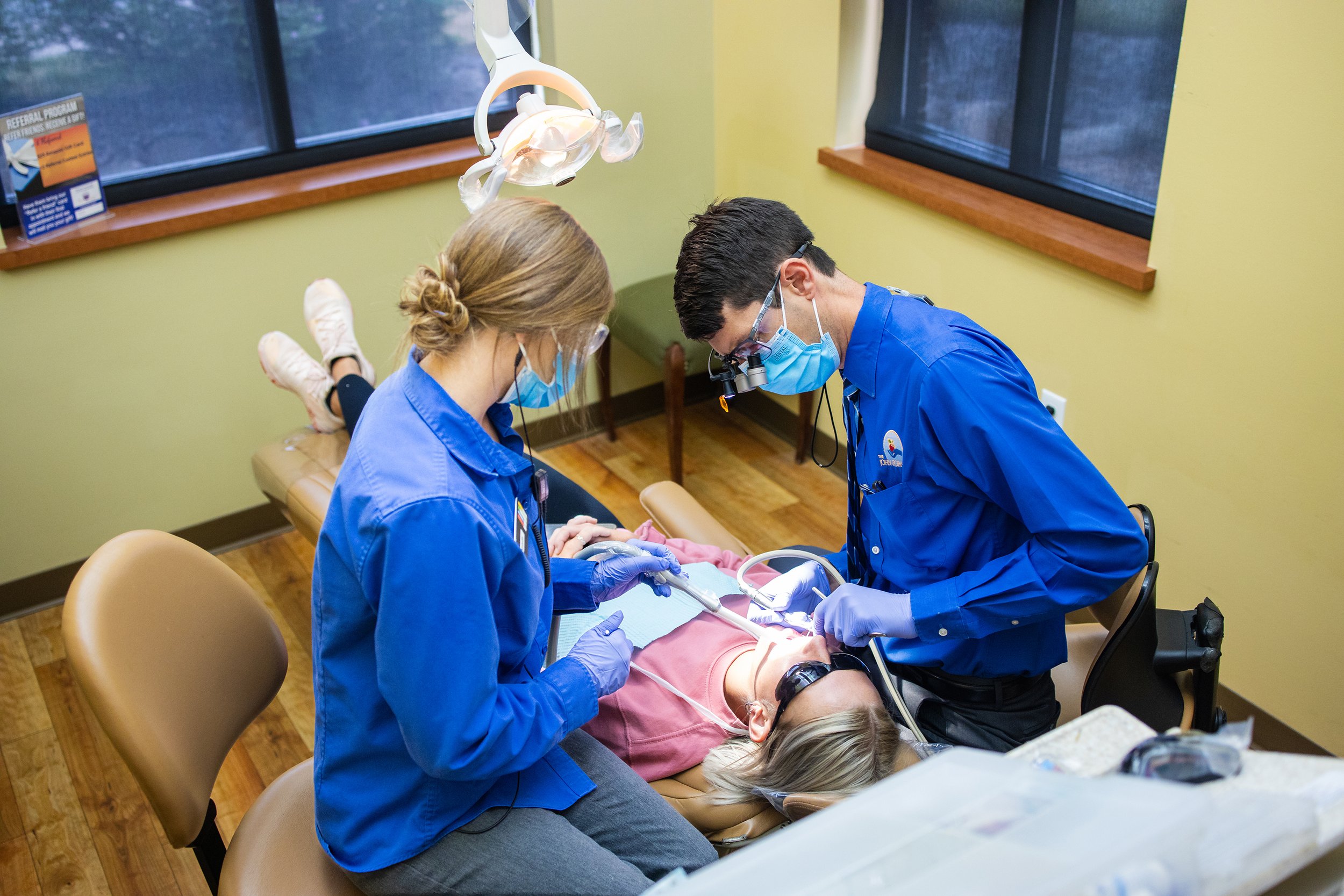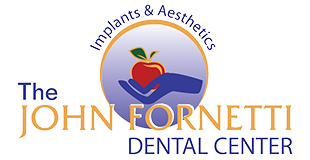General Dentistry
While we are on the cutting edge of specialty treatments, we still always prefer to preserve and maintain your teeth rather than replace them. Regular professional cleanings along with daily brushing and flossing is the best way to prevent tooth loss and also to maintain optimal oral health. Our general dentistry guests receive regular cleaning, polishing and education that complement at-home care and help establish strong, healthy teeth.
Our General Dentistry Services Include:
Fluoride, Sealants, Root Canals, Fillings, Gum Disease Treatment and Management, Oral Cancer Screenings
Our staff is also well versed in working with young patients, helping to make a child’s experience with the dentist a positive one. For children new to us that are coming from a previous bad experience we do offer sedation dentistry.
-
Protect Your Smile.
You brush your teeth twice a day, floss regularly and visit the dentist every six months, but did you know that rinsing with fluoride — a mineral that helps prevent cavities and tooth decay — also helps keep your teeth healthy and strong? It is effective in preventing cavities and tooth decay by coating your teeth and preventing plaque from building up and hardening on the tooth’s surface.
Two varieties, topical and systemic:
Topical fluoride is applied directly to the tooth and includes toothpastes and mouth rinses.
Systemic fluorides are generally only used by your dentist and are not often available for at-home use. These treatments are generally designed to help protect the oral health of children undergoing dental procedures. Fluoride used in the dentist or orthodontist’s office is often a much stronger concentration than what’s found in toothpaste or mouthwash, but is available at some drug stores or a pharmacy (ask your dentist before purchasing professional-strength fluoride).
Receiving treatment from your dentist:
A fluoride treatment in your dentist’s office takes just a few minutes. After the treatment, patients may be asked not to rinse, eat, or drink for at least 30 minutes in order to allow the teeth to absorb the fluoride. Depending on your oral health or your doctor’s recommendation, you may be required to have this type of treatment every three, six, or 12 months. Your doctor may also prescribe an at-home fluoride product such as a mouthwash, gel, or antibacterial rinse.
How to choose the right fluoride treatment:
When choosing your own at-home product (such as toothpaste or mouthwash), always check for the American Dental Association’s (ADA) seal of acceptance. Products marked with the ADA seal of approval have been carefully examined by the ADA, and approved based on safety and effectiveness. Take care of your teeth and smile bright with at-home treatments!
-
Sealants keep your teeth healthy.
When Brushing Does Not Cut It.
Sometimes brushing is not enough, especially when it comes to those hard-to-reach spots in your mouth. It is difficult for your toothbrush to get in between the small cracks and grooves on your teeth. If left alone, those tiny areas can develop tooth decay. Sealants give your teeth extra protection against decay and help prevent cavities.
What Is It?
Dental sealants are plastic resins that bond and harden in the deep grooves on your tooth’s surface. When a tooth is sealed, the tiny grooves become smooth and are less likely to harbor plaque. Brushing your teeth becomes easier and more effective when you seal those deep grooves.
Who Is It For?
Sealants are typically applied to children’s teeth after their permanent teeth have erupted as a preventive measure against tooth decay. However, adults can also receive sealants on healthy teeth. It is more common to seal permanent teeth rather than baby teeth, but every patient has unique needs, and your dentist will recommend this treatment on a case-by-case basis.
How Long Does It Last?
Sealants typically last from three to five years, although it is fairly common to see adults with sealants still intact from childhood. They only provide protection when they are fully intact so if your sealants come off, let your dentist know, and schedule an appointment for your teeth to be resealed.
-
Traditional dental restoratives, or fillings, include gold, porcelain, and composite. The strength and durability of traditional dental materials make them useful for situations where restored teeth must withstand extreme forces that result from chewing, often in the back of the mouth.
Newer dental fillings include ceramic and plastic compounds that mimic the appearance of natural teeth. These compounds, often called composite resins, are usually used on the front teeth where a natural appearance is important, but they can also be used on the back teeth depending on the location and extent of the tooth decay.
What’s right for me?
Several factors influence the performance, durability, longevity and expense of dental restorations, including the components used in the filling material, the amount of tooth structure remaining and where and how the filling is placed. Your dentist will also consider the chewing load that the tooth will have to bear and the length and number of visits needed to prepare and adjust the restored tooth.
Before your treatment begins, your doctor will discuss with you all of your options and help you choose the best filling for your particular case. In preparation for this discussion it may be helpful to understand the two basic types of dental fillings — direct and indirect.
Direct fillings are fillings placed into a prepared cavity in a single visit. They include glass ionomers, resin ionomers, and composite (resin) fillings. The dentist prepares the tooth, places the filling, and adjusts it in one appointment.
Indirect fillings generally require two or more visits. They include inlays, onlays, veneers, crowns, and bridges fabricated with gold, base metal alloys, ceramics, or composites. During the first visit, the dentist prepares the tooth and makes an impression of the area to be restored. The dentist then places a temporary covering over the prepared tooth. The impression is sent to a dental laboratory, which creates the dental restoration. At the next appointment, the dentist cements the restoration into the prepared cavity and adjusts it as needed.
-
Gum disease, also known as periodontal disease, is an infection of the gums surrounding your teeth. Gum disease is one of the top reasons for tooth loss in adults, and because it is virtually pain-free, many patients do not know they have the disease. During each regular checkup, your dentist will check for signs of periodontal disease by measuring the space between your teeth and gums.
What causes gum disease?
Gum disease is caused by a buildup of plaque (a sticky form of bacteria that forms on the teeth). If the plaque is not removed (by flossing, brushing, and regular dental checkups), it will continue to build up and create toxins that can damage the gums. Periodontal disease forms just below the gum line and creates small pockets that separate the gums from the teeth. Periodontal disease has two stages: gingivitis and periodontitis.
Gingivitis
This is the early stage of gum disease, when the gums become red and swollen, and bleed easily. At this stage, the disease is treatable and can usually be eliminated by daily brushing and flossing.
Periodontitis
If left untreated, gingivitis will advance into periodontitis, and the gums and bone that support the teeth will become seriously and irreversibly damaged. Gums infected with periodontitis can cause teeth to become loose, fall out, or be removed by a dentist.
Certain factors can increase a patient’s risk of developing periodontal disease, including:
Smoking or using chewing tobacco
Diabetes
Certain types of medication such as steroids, anti-epilepsy drugs, cancer therapy drugs, calcium channel blockers, and oral contraceptives
Bridges that no longer fit properly
Crooked teeth
Old fillings
Pregnancy
While it is possible to have periodontal disease and not know it, some symptoms can include:
Gums that bleed easily
Red, swollen, tender gums
Gums that have pulled away from the teeth
Persistent bad breath or bad taste
Pus between your teeth and gums
Permanent teeth that are loose or separating
Any change in the way your teeth fit together when you bite
Any change in the fit of partial dentures
Treatments for gum disease can vary depending on the severity of each individual case. Typical treatments include:
Non-surgical treatments such as at-home periodontal trays, and scaling and root planing (deep cleaning)
Periodontal surgery and laser gum surgery
Dental implants
Preventing Gum Disease
Regular dental checkups and periodontal examinations are important for maintaining your health and the health of your smile. You don’t have to lose teeth to periodontal disease, and by practicing good oral hygiene at home, you can significantly reduce your chances of ever getting gum disease. Remember to brush regularly, clean between your teeth, eat a balanced diet, and schedule regular dental visits to help keep your smile healthy.
-
Your Overall Wellness:
Our office is not only dedicated to your smile, we’re also dedicated to your overall wellness. We take a holistic approach to your dental care, which includes an oral cancer screening as a part of your regular exam. Like any kind of cancer, oral cancer can be life threatening if not diagnosed and treated early. You are the most important factor in the early diagnosis of oral cancer through routine screenings at our office.
We have the skills and tools to ensure that early signs and symptoms of oral cancer and pre-cancerous conditions are identified. While these symptoms may be caused by other, less serious problems, it is very important to visit our office to rule out the possibility of oral cancer.
Common Symptoms:
Red or white spots or sores anywhere in the oral cavity
A sore that bleeds easily or does not heal
A lump, thickening or rough spot
Pain, tenderness or numbness anywhere in the mouth or on the lips
Difficulty chewing, swallowing, speaking or moving the jaw or tongue
Our team is trained in a simple, quick screening, which involves an examination of your mouth as a whole and not just your teeth to detect cancerous and pre-cancerous conditions. Besides a visual examination of your mouth, we will also feel the tissue of your mouth and throat to detect any abnormalities. If we find an area of concern, we may perform a simple test, such as a brush test, which collects cells from a suspicious lesion in the mouth to be sent to a laboratory for analysis. If this test comes back atypical or positive, we may recommend a biopsy.
What can you do?
Aside from receiving an oral cancer screening during your checkup at our office, there are many things you can do to help prevent oral cancer:
The best way to prevent oral cancer is to avoid all tobacco products and only drink alcohol in moderation.
Maintain a healthy, balanced diet.
Limit your exposure to the sun and always wear UVA- and UVB-blocking sun protective lotions on your skin as well as your lips.
During your next dental appointment, ask your dentist to perform an oral exam. Early detection of oral cancer can improve the chance of successful treatment.

